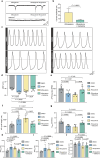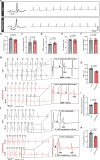A GABAergic system in atrioventricular node pacemaker cells controls electrical conduction between the atria and ventricles
- PMID: 38849501
- PMCID: PMC11291642
- DOI: 10.1038/s41422-024-00980-x
A GABAergic system in atrioventricular node pacemaker cells controls electrical conduction between the atria and ventricles
Abstract
Physiologically, the atria contract first, followed by the ventricles, which is the prerequisite for normal blood circulation. The above phenomenon of atrioventricular sequential contraction results from the characteristically slow conduction of electrical excitation of the atrioventricular node (AVN) between the atria and the ventricles. However, it is not clear what controls the conduction of electrical excitation within AVNs. Here, we find that AVN pacemaker cells (AVNPCs) possess an intact intrinsic GABAergic system, which plays a key role in electrical conduction from the atria to the ventricles. First, along with the discovery of abundant GABA-containing vesicles under the surface membranes of AVNPCs, key elements of the GABAergic system, including GABA metabolic enzymes, GABA receptors, and GABA transporters, were identified in AVNPCs. Second, GABA synchronously elicited GABA-gated currents in AVNPCs, which significantly weakened the excitability of AVNPCs. Third, the key molecular elements of the GABAergic system markedly modulated the conductivity of electrical excitation in the AVN. Fourth, GABAA receptor deficiency in AVNPCs accelerated atrioventricular conduction, which impaired the AVN's protective potential against rapid ventricular frequency responses, increased susceptibility to lethal ventricular arrhythmias, and decreased the cardiac contractile function. Finally, interventions targeting the GABAergic system effectively prevented the occurrence and development of atrioventricular block. In summary, the endogenous GABAergic system in AVNPCs determines the slow conduction of electrical excitation within AVNs, thereby ensuring sequential atrioventricular contraction. The endogenous GABAergic system shows promise as a novel intervention target for cardiac arrhythmias.
© 2024. The Author(s).
Conflict of interest statement
The authors declare no competing interests.
Figures








Similar articles
-
Transcriptional Patterning of the Ventricular Cardiac Conduction System.Circ Res. 2020 Jul 17;127(3):e94-e106. doi: 10.1161/CIRCRESAHA.118.314460. Epub 2020 Apr 15. Circ Res. 2020. PMID: 32290757 Free PMC article.
-
Computational modelling of mouse atrio ventricular node action potential and automaticity.J Physiol. 2024 Oct;602(19):4821-4847. doi: 10.1113/JP285950. Epub 2024 Sep 13. J Physiol. 2024. PMID: 39269369
-
Molecular characterization of the ventricular conduction system in the developing mouse heart: topographical correlation in normal and congenitally malformed hearts.Cardiovasc Res. 2001 Feb 1;49(2):417-29. doi: 10.1016/s0008-6363(00)00252-2. Cardiovasc Res. 2001. PMID: 11164852
-
The atrioventricular node: origin, development, and genetic program.Trends Cardiovasc Med. 2010 Jul;20(5):164-71. doi: 10.1016/j.tcm.2011.02.001. Trends Cardiovasc Med. 2010. PMID: 21742272 Review.
-
Optical mapping of the atrioventricular junction.J Electrocardiol. 2005 Oct;38(4 Suppl):121-5. doi: 10.1016/j.jelectrocard.2005.06.024. J Electrocardiol. 2005. PMID: 16226086 Review.
Cited by
-
An optimized Langendorff-free isolating method and electrophysiology studies for adult mouse atrioventricular node cells.BMC Cardiovasc Disord. 2025 Jul 3;25(1):459. doi: 10.1186/s12872-025-04888-1. BMC Cardiovasc Disord. 2025. PMID: 40610851 Free PMC article.
References
MeSH terms
Substances
Grants and funding
LinkOut - more resources
Full Text Sources
Molecular Biology Databases

